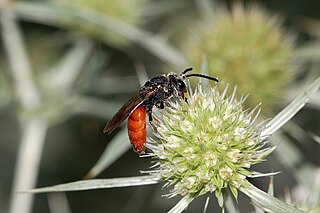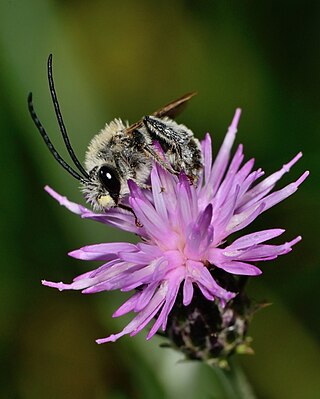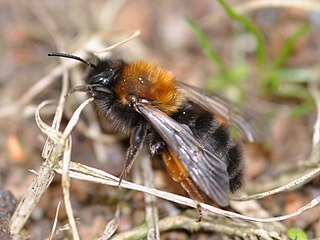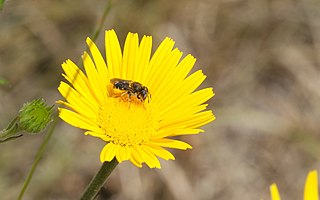
The Eucerini are the most diverse tribe in the family Apidae, with over 32 genera worldwide that were previously classified as members of the family Anthophoridae. All species are solitary, though many nest in large aggregations, and large "sleeping" aggregations of males are found occasionally. Most genera are distinctive in the unusually long male antennae from which the tribe derives its name. They are most diverse in the Western Hemisphere.

Sphecodes albilabris is a solitary parasitic bee that is endemic to Central and Western Europe. It also occurs in North Africa and is thought to have been introduced to the United States and Australia by accident.

Osmia cornuta, the European orchard bee, is a species of bee in the genus Osmia.

Andrena marginata, sometimes called the small scabious mining bee is a species of the sand bee (Andrena) genus.

Andrena hattorfiana is a species of mining bees belonging to the family Andrenidae subfamily Andreninae.

Eucera is a genus of bees in the family Apidae, which comprises more than 100 species. These bees are commonly known as long-horned bees due to their characteristically long antennae, especially in males. Eucera species can be found in diverse habitats, including meadows, fields, and urban gardens, primarily in the Palearctic and Nearctic regions, covering parts of Europe, Asia, North Africa, and North America.

Cerceris rybyensis, the ornate tailed digger wasp, is a Palearctic species of solitary wasp from the family Crabronidae which specialised in hunting small to medium-sized mining bees. It is the type species of the genus Cerceris and was named as Sphex rybyensis by Carl Linnaeus in 1771.

The Clark's miner bee is a species of miner bee in the family Andrenidae. Other common names include Clark's andrena and Clarke's mining bee. It is found in Europe and Northern Asia and North America.

Hylaeus communis is a Palearctic species of solitary bee.

Osmia aurulenta is a Palearctic species of mason bee.

Tetralonia malvae, also known as the Mallow longhorn, is a species of insect belonging to the family Apidae. The bee takes pollen from oligolectic sources on the mallow family (Malvaceae).

Bombus semenoviellus is a species of insect belonging to the family Apidae.

Camptopoeum friesei is a species of bees of the genus Camptopoeum.

Anthophora bimaculata is a species of bee.
Hoplitis mocsaryi is a species of bees in the genus Hoplitis.
Coelioxys polycentris is a species of leaf-cutting cuckoo bee native to Europe and the Near East.

Osmia spinulosa, also known as the spined mason bee, is a species of bees within the genus Osmia.

Trachusa byssina is a species of bees within the genus Trachusa.
















